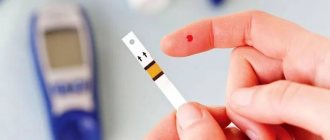Why is insulin resistance dangerous?
Even in people without serious changes in metabolism, insulin resistance triggers the processes of early aging; it is also known today that it is precisely it that is associated with severe cardiovascular pathologies and their dangerous complications (stroke, heart attack, acute cerebrovascular accidents, diabetic neuropathy, etc.).
Insulin resistance is very common. In 10-15% of adults (without chronic diseases and diagnoses) it can be detected by chance, during any examinations. This means that thousands of people not only do not know about it, but are also at risk of dangerous diseases!
It may seem that insulin resistance is a very insidious and hidden enemy of health, but in fact this disguise is very arbitrary, because a deviation can be suspected in the presence of specific problems in appearance and well-being.
For example, all women, especially middle-aged women, are familiar with the problem of being overweight. There comes a time when extra pounds literally become fused with the body, it is almost impossible to lose them, no diets help. Moreover, it feels like the excess weight is concentrated in the abdominal area - which is why many women dream of losing weight specifically at the waist, pumping up their abs, without attaching importance to other parts of the body. Meanwhile, age
and
the accumulation of adipose tissue in the abdominal area
(the so-called abdominal obesity, of the central type) are two of the most important factors that trigger the development of insulin resistance and support its strengthening.
Women over 35 years of age may experience various hormonal abnormalities.
, which at this age do not yet lead to the development of diseases, but create a “storm” in the body. Fluctuations in the content of estrogen and testosterone (and long before the onset of menopause), a decrease in the concentration of thyroid hormones and an increased release of stress hormones - adrenaline, cortisol - all this primarily affects physical health. Problems that are related to each other are gradually accumulating: excess weight, increased cholesterol levels in the blood, high blood pressure. Insulin resistance can be either a consequence of these changes in the body or their faithful companion.
Bad habits, lack of physical activity, and a diet based on fast food contribute to the development of insulin resistance.
and generally
poor quality of food
. By the way, strict diets and other food restrictions can also be attributed to poor quality of nutrition: the body does not get better from them, and the constant “swing” of losing and gaining weight only increases the tendency to insulin resistance.
If you think about it, in the lives of each of us there are at least a couple of the listed harmful factors, so if some problem has been bothering you for a long time and seriously (can’t lose weight, constantly high blood pressure, headaches and weakness), you should consult a doctor and describe him a complete picture of his symptoms. It’s not uncommon to dot all the points
i is assisted by an endocrinologist and carrying out several tests (glucose, glucose tolerance test, glycated hemoglobin, insulin resistance index, etc.).
Complexes with this research
Advanced anti-aging diagnostics in postmenopause Advanced monitoring of age-related changes during the postmenopausal period 29,230 ₽ Composition
Advanced male anti-aging diagnostics Advanced monitoring of key indicators in men aged 40+ 33,710 ₽ Composition
Monitoring diabetes Monitoring the condition of patients with diabetes (once every 6 months) 1,900 ₽ Composition
IN OTHER COMPLEXES
- Male anti-aging diagnostics RUB 13,300
- Women's anti-aging diagnostics RUB 12,070
- Advanced women's anti-aging diagnostics RUB 28,680
- Anti-aging diagnostics in postmenopause RUB 12,630
The role of insulin in the body
Insulin is the most important hormone secreted by the pancreas, and the only
a hormone in the body that lowers the concentration of glucose in the blood. Insulin is involved in many important biological reactions, such as activating the formation of proteins in muscles and supporting the storage of fats in the liver, but it is the regulating effect on glucose that is the basis of its unique action.
Many tissues in the body are dependent on the presence of insulin: these are, first of all, muscle and adipose tissue (and all other tissues except nervous tissue). Insulin works like a key here - it opens the access of glucose into the cell, where it is used for energy and burned. If this mechanism stops working, cells become insensitive to insulin and insulin resistance
.
Insulin resistance, diabetes and metabolic syndrome
Tissue resistance to the action of insulin is associated primarily with the development of type 2 diabetes mellitus, but a clear connection has also been identified with obesity, arterial hypertension, and severe lipid metabolism disorders. When insulin resistance is combined with other factors and indicators of the body, they speak of metabolic syndrome (insulin resistance syndrome). When making such a diagnosis, many indicators are important, but the most basic are the following (a combination of at least 3 of them):
- waist circumference more than 102 cm in men and more than 88 cm in women, this is the so-called central obesity, accumulation of fatty tissue in the abdominal area,
- persistent fasting blood glucose level of more than 6.1 mmol/l (with a normal value of up to 5.5 mmol/l),
- blood pressure level 130/85 mmHg. and higher,
- the level of “good” cholesterol (high-density lipoprotein, HDL) is less than 1 mmol/l for men, less than 1.3 mmol/l for women,
- triglyceride level more than 1.7 mmol/l.
It is important to detect pathological changes in the body in time and begin treatment, the basis of which is, first of all, lifestyle changes and proper nutrition. An endocrinologist will create a diet, recommend an activity regimen and, if necessary, medications.
Correction of insulin resistance and metabolic syndrome
In both cases, the problem is solvable: today effective schemes for correcting these metabolic disorders have been developed. With a competent professional approach, it is possible to restore insulin sensitivity, improve metabolism and bring the body back to normal.
Diet therapy
Following a certain diet, as a result of which body weight is reduced, is a measure that cannot be avoided! Often, weight loss alone leads to improved well-being, mitigation of chronic diseases (arterial hypertension, coronary heart disease, fatty liver disease and others), and normalization of test parameters (for example, cholesterol concentration decreases, cholesterol concentration increases).
Moreover, the diet recommended by world medical communities has nothing in common with diets for quick weight loss: slow loss of kilograms (from 500 g to 1 kg per week, over 4-6 months) is important for the health and restoration of the body, so In this way, up to 15% of the original weight is lost, and the risk of returning kilograms is very low.
You need to be careful with diets that allow you to lose more than 5 kg per month, as this can increase metabolic disorders and subsequently lead to weight gain. Strict diets have a negative impact on the psychological state, especially in women in the initial period of menopause; the need to follow a diet in itself is unpleasant, so the body requires compensation! Because of this, against the background of constant hunger, overeating is possible, and against the background of stress, a return to bad habits (smoking, alcohol). In addition, severe dietary restrictions (no carbohydrates, very low calorie content, etc.) not only lead to loss of muscle mass, but also contribute to the development or strengthening of insulin resistance.
Nutrition is based on the principles of a healthy lifestyle:
- foods with high energy density (animal fats, baked goods, carbonated drinks, etc.) are limited or completely eliminated;
- foods with low energy density are consumed in large quantities (vegetables, cereals);
- semi-finished products and fast food are completely excluded from the diet;
- “fast” carbohydrates are limited (not completely eliminated); It is often recommended to avoid their use in the morning for several reasons:
- they quickly break down and lead to a sharp jump in the concentration of glucose in the blood;
- insulin is released in high concentrations in response to meals high in simple carbohydrates;
- if a person has insulin resistance, insulin cannot “open” channels for the absorption of glucose in cells, it turns out that there is a high concentration in the blood of both glucose - because it is not processed, and insulin - because it is released in response to food intake; this means poor health and increased metabolic disorders in the body;
- alcohol is limited (mainly beer and sweet wines are prohibited),
- the number of calories and the composition of the diet is determined individually with the participation of an endocrinologist (nutritionist).
Physical activity
Physical education is necessary for people with any body weight, since it is physical activity that consolidates the effect of weight loss and has a positive effect on the cardiovascular and musculoskeletal systems. Participation in the process by a sports doctor, fitness trainer or exercise therapy instructor is very important, as this guarantees the absence of adverse events during exercise, good health and reduces the risk of exacerbations of chronic diseases.
Treatment of existing diseases and abnormalities
The entire process of correcting insulin resistance and metabolic syndrome is impossible without treating existing diseases. This may be arterial hypertension, angina pectoris, diabetes mellitus, diseases of the digestive system, joints and spine. It is necessary to follow all doctor’s recommendations for the use of medications for these pathologies.
Diagnosis and correction of insulin resistance at the TN Clinic.
A variety of tests are performed to determine insulin resistance and hidden diabetes. The following are of greatest practical importance:
oral glucose tolerance test,
during which the level of glucose in the blood (from a vein) is assessed twice - before and after (2 hours) taking 75 ml of glucose solution; the test is performed if fasting glucose concentrations are abnormal or if there is a high risk of developing diabetes; the analysis is taken strictly on an empty stomach;
DNA tests;
blood test for glycated hemoglobin
(the form of hemoglobin formed when combined with glucose) reflects the average blood glucose level over the past 3 months; used, among other things, for diagnosing latent diabetes mellitus; The analysis is done on an empty stomach.
Evaluating test results is the doctor’s task. At the TN-Clinic, experienced endocrinologists will analyze the data obtained and, if necessary, draw up a plan for correcting the condition. Research and evaluation of results take several hours, the patient remains in the clinic all this time.
By contacting the TN Clinic, you can find out exactly what is causing your excess weight, appearance and health problems. Small adjustments to your diet and lifestyle can help you return to a normal weight and improve your health.
Sample diet menu No. 9.
- First breakfast: buckwheat porridge (cereals - 40 g, butter - 5 g), meat pate (meat - 60 g, butter - 10 g), tea with milk (milk - 50 g).
- Second breakfast: a glass of kefir.
- Lunch: vegetable soup (oil - 5 g, potatoes - 50 g, cabbage - 100 g, carrots - 25 g, sour cream - 10 g, tomatoes - 20 g), boiled meat with potatoes (meat - 100 g, potatoes - 150 g , oil – 5 g), apple (200 g).
- Afternoon snack: yeast drink.
- Dinner: carrot zrazy with cottage cheese (carrots - 75 g, cottage cheese - 50 g, egg - 1 pc., sour cream - 10 g, semolina - 8 g, crackers - 5 g), boiled fish with cabbage (fish - 100 g , vegetable oil – 10 g, cabbage – 150 g), tea.
- 1.5 hours before bedtime: a glass of kefir.
- Bread for the whole day: wheat – 130 g, rye – 250 g.
It is worth paying attention to the possible interchangeability of products. So, 25 g of wheat bread is replaced by: 18 g of wheat flour, 20 g of rice, 20 g of oatmeal, 18 g of pasta, 60 g of potatoes, 180 g of carrots, 135 g of apples, 150 g of pears (peeled vegetables).
A medical diet is prescribed only by the attending physician , who has full knowledge of the medical history of a particular patient.
Comments from nutritionists
Anastasia, 48 years old, Chelyabinsk The menu has a lot of products and dishes, there are few restrictions, it’s easy to follow the rules.
The main advantage: the diet does not require fasting. Even when the urge is weak, you can find a low-calorie snack. The only inconvenience is associated with giving up fast carbohydrates. Some patients do not tolerate restrictions well in the initial stages. You can cope with this by gradually eliminating dangerous products. Sweets can be replaced with dried fruits and honey, but portions must be limited. Olga, 35 years old, Omsk It would be more correct to call this system not a diet, but a healthy diet. Patients should adhere to it throughout their lives. It is strongly recommended not to limit yourself to diet, but to visit a doctor and be observed by him. Each patient needs to create an individual diet, since everyone’s reaction to foods is different. For example, some people tolerate honey and grapes well, while others experience increased glucose levels even after eating whole grain cereals and legumes.
Proper physical activity
To effectively increase insulin sensitivity, the following types of exercise are preferred:
- Power. The load should be short but intense. It helps reduce glycogen stores in the liver and muscles and prepares storage space for sugar.
- Walks. In the process of walking, the body no longer burns sugar, but fats.
- Swimming. Similar to walking. This sport is preferable for obese people, since the load on the legs is reduced in water.
It is advisable to switch to a more active lifestyle. Cycling is encouraged. It is recommended to exercise during the day. Even circling around the room makes it easier for sugar to enter the cells.
What can you drink
The following drinks are allowed to be consumed during IR:
- mineral water;
- cocoa without sugar;
- coffee in limited quantities, no more than 2-3 small cups per day;
- jelly with oatmeal;
- compote;
- kvass;
- tea;
- milk.
In case of IR, it is allowed to drink mineral water.









